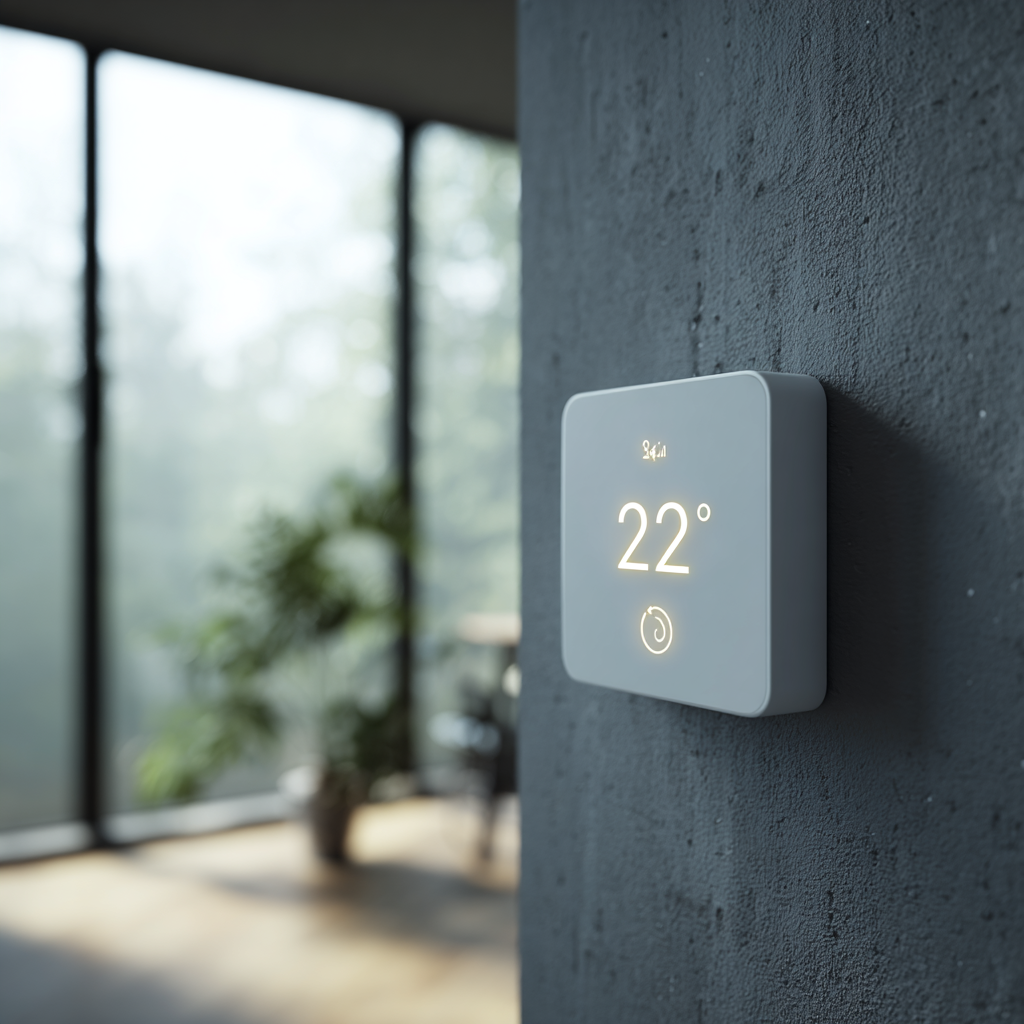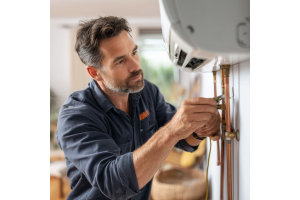
Upgrade your home heating controls for comfort, efficiency and modern connectivity
With heating costs high and the push for smarter, greener homes stronger than ever, installing a smart thermostat is one of the most effective upgrades for a UK home. But with so many options, brands and compatibility issues, how do you pick the right one? In this detailed guide we’ll cover everything you need to know — and highlight the best models worth considering.
1. What is a smart thermostat — and why it matters
What is a smart thermostat?
A smart thermostat does everything a traditional room thermostat or programmer can do — but adds connectivity, automation and intelligence. You can control heating (and often hot water) via a smartphone app or voice assistant, set flexible schedules, use sensors/learning features and monitor usage.
Why upgrade?
-
Remote control: adjust your heating while you’re out or on holiday.
-
Smart scheduling & automation: avoid heating an empty home, reduce waste.
-
Improved energy efficiency and cost savings: Many sources estimate savings of 8-31% depending on household and usage.
-
Integration with modern heating systems (heat pumps, low-carbon tech) and smart homes.
-
Added comfort and control: Some models learn your routines, adapt to your home’s thermal behaviour.
Are they really worth it in the UK?
Yes — provided you have a compatible heating system, you install them correctly, and use the features. Many UK guides emphasise that while they don’t guarantee huge savings, they enable smarter control and therefore potentially lower bills.
Also, as UK homes increasingly adopt low-carbon heating (heat pumps, solar etc), smart controls become more valuable.
2. What to consider when choosing a smart thermostat in the UK
Compatibility
-
Check your boiler type (gas, oil, electric, heat pump). Some smart thermostats are designed for certain systems.
-
Wiring: Some homes might need a “C-wire” (common wire) or relay for older systems.
-
App / ecosystem: Does it integrate with Amazon Alexa, Google Home, Apple HomeKit?
-
Multi-zone or single zone? Larger homes might benefit from thermostat + TRVs or multiple zones.
Features
Look for:
-
Remote app control
-
Scheduling (daily/weekly)
-
Learning/auto-adaptation
-
Geofencing (detect when you’re away)
-
Energy usage reports
-
Integration with other smart devices and heating/hot water control.
Usability & interface
A well-designed app, easy wall interface, reliability of connection and updates matter (especially in the UK with variable broadband / WiFi).
Also look at quality of installation (some may require a qualified engineer).
Cost vs saving
While the device cost is modest (often ~£100-£250), you need to consider installation, and the real savings depend on your usage, how well-insulated your home is, and your existing system. One guide says savings of 8-31%.
Future-proofing
-
With changes in support (for example older models may lose app support) you want something supported long term.
-
UK legality/standards: Ensure your thermostat meets UK standards and works with your boiler.
-
Works well with heat pumps, modern systems, and smart home integration.
User-specific considerations
-
Living in a rental property? Ensure landlord approves, check wiring.
-
Older home with poor insulation? A smart thermostat helps but insulation upgrades may yield more benefit.
-
Multi-storey home or open-plan layout? You may need more advanced zoning for best results.
3. Our top smart thermostat picks for UK homes
-
Google Nest Learning Thermostat (3rd Gen): A flagship, feature-rich model with learning behaviour and great design. Ideal if you want a “set it and forget it” smart thermostat.
-
tado° Smart Thermostat Starter Kit V3+: Popular in the UK, strong app support, geofencing, works well with many systems.
-
Honeywell Home Lyric T6R Smart Wireless Thermostat: Excellent multi-zone and wireless option from a trusted heating-controls brand.
-
Netatmo Smart Thermostat by Starck: Design-led smart thermostat, good choice if aesthetics matter alongside functionality.
-
Ariston CUBE S NET Smart Thermostat: Higher budget choice, strong features, good for more advanced systems.
-
Honeywell Home Lyric T6 Smart Wired Thermostat: Wired version for homes with traditional wiring — useful upgrade path.
-
Bosch Smart Thermostat II: Value brand, good for more straightforward systems.
-
Netatmo Smart Thermostat + Valves Pack: A complete pack for room-by-room control (thermostat + radiator valves) — ideal for larger homes or zoned control.
4. Which smart thermostat suits your home?
Here are some typical scenarios:
-
Smaller UK home / flat: One zone, standard gas boiler → A mid-range smart thermostat (e.g., Netatmo, Bosch) is sufficient.
-
Larger home, multiple rooms / zones: Consider a system with multi-zone support (e.g., Honeywell Lyric T6R) or a thermostat + smart radiator valves.
-
Upgrading to heat pump / low-carbon system: Choose models that support heat pump integration or future-proofing.
-
Modern design-conscious home: Design-led thermostats like Netatmo by Starck help integrate with interiors.
-
Budget-sensitive upgrade: A value model still offers many benefits; ensure compatibility and wiring.
-
Rental property / landlord scenario: Smart thermostat with remote access can be helpful, but ensure wiring/license/permissions are in place.
5. Installation & setup – best practice for UK homes
Pre-installation checklist
-
Confirm your boiler and heating system compatibility.
-
Check wiring: is there a live common (C) wire? If not, some thermostats may need a retrofit or adaptor.
-
WiFi / network coverage: Ensure the thermostat location has good signal.
-
Location: The thermostat should be placed in a representative room (not next to heat sources, draughts or large windows) for accurate control.
-
Backup: Ensure manual override is possible in case of connectivity issues.
Installation tips
-
If unsure, use a qualified heating engineer or electrician, especially when dealing with mains wiring.
-
Set up via app: connect to your WiFi, set your home/away schedule, geo-fencing.
-
Calibrate: Let the thermostat learn your home heat-up behaviour (if applicable).
-
Test: Run the system manually, check response, test away mode or remote control.
-
Monitor: Over the first few weeks check how your home heats, make adjustments as needed.
Post-install maintenance
-
Update the app/firmware when prompted.
-
Regularly review heating schedules, especially when your routine changes (e.g., working from home).
-
Monitor energy usage: Many apps provide insights.
-
If system changes (new boiler, insulation upgrade), consider re-calibrating or reassessing your thermostat setup.
6. Maximising benefits & avoiding pitfalls
Maximising benefits
-
Use the geo-fencing/away mode: turns heating off when no one’s home and on before you get back.
-
Use smart schedules: Align heating to your real life (not just fixed “9-5”).
-
Pair with other upgrades: Good insulation, efficient boiler, smart radiators all enhance the value of a smart thermostat.
-
Zone control: If you have different heating needs in different rooms, use thermostats + TRVs or multi-zone solutions.
-
Monitor usage: The data your thermostat gives you can highlight inefficiencies (e.g., overheating an unused room).
Common pitfalls
-
Incompatible system: If your boiler or wiring isn’t compatible you’ll run into problems.
-
Poor placement: If the thermostat senses a distorted temperature (e.g., near radiators, windows, doors) it may switch off prematurely or inefficiently.
-
Over-reliance on “set it and forget it”: A smart thermostat still needs sensible settings and occasional review of schedules.
-
Ignoring fundamentals: If your home is poorly insulated or heavily draughty, the thermostat can only do so much.
-
Connectivity issues: WiFi dropouts, app bugs or firmware issues may reduce functionality.
-
Support/updates: Some older models may lose app support. For example, a UK news piece noted older models of a major brand will soon lose app control.
7. UK-Specific Considerations
-
UK building fabric: Many UK homes are older, with variable insulation. A smart thermostat will help, but insulation, radiators and boiler efficiency matter too.
-
Heating patterns: UK households often heat intermittently (morning & evening), so scheduling and remote control are ideal.
-
System types: Many UK homes have gas boilers; some are moving to heat pumps. Make sure your thermostat supports your system.
-
Government/industry trends: With the drive to reduce carbon emissions, smart controls are increasingly valued.
-
Support & warranty: Choose a brand with good UK support, updates and service.
-
Installation cost & compatibility: Check if your installer can handle smart controls; some older properties may need rewiring or additional modules.
8. How we picked our recommendations
Our selections were based on:
-
UK market availability and compatibility
-
Brand reputation and support
-
Feature-richness vs cost
-
Ease of installation and usability
-
App and smart home integration
-
Forward-compatibility (heat pump support, zoning)
9. Final summary & recommendation
If you’re looking to upgrade your home heating controls, a smart thermostat is a very strong step. For UK homes, we recommend:
-
If you have a standard single-zone system, pick a good mid-range model (e.g., Netatmo, Bosch) and ensure compatibility.
-
If you have multiple zones or a larger home, choose a multi-zone system (e.g., Honeywell Lyric) or a thermostat + smart radiator valve setup.
-
If you want premium features (learning, advanced analytics) and design appeal, go for flagship (e.g., Nest).
-
Always ensure your underlying heating system (boiler, insulation, radiators) is up to scratch — the thermostat will help you optimise, but won’t fix fundamental inefficiencies.
-
Plan installation carefully: compatibility, wiring, placement and WiFi are key.
-
Use the features: scheduling, away mode, data insights — this is where the savings and comfort come from.
For UK homeowners seeking better comfort, control, and efficiency — especially with rising energy bills — a well-chosen smart thermostat offers excellent value.
At Geyser, we can help you select the right smart thermostat for your home, check compatibility with your boiler/heating system, and refer reliable installers. If you’d like guidance on which model suits your home best, get in touch with us.
Ready to upgrade? Browse our range of smart thermostats at Geyser, and check compatibility with your heating system today. Need advice or installation? Contact our team for a free compatibility check and quote.







